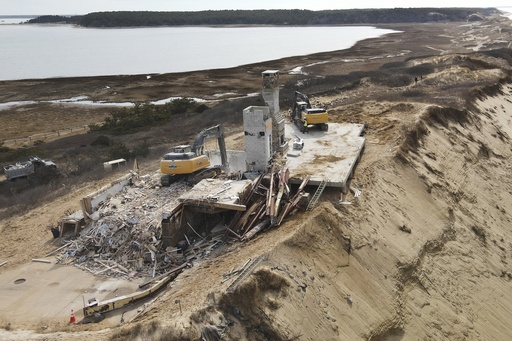In Wellfleet, Massachusetts, a luxury residence poised to plummet into Cape Cod Bay due to severe erosion has been dismantled. This 5,100-square-foot house had posed a potential threat to the nearby oyster beds at Wellfleet Harbor, but disputes surrounding its removal left it precariously perched on the brink of a sandy bluff for several months. On Monday, the demolition commenced as heavy machinery methodically dismantled the structure, piece by piece, loading the remnants onto trucks for disposal. By Tuesday, all that remained was the concrete foundation, a chimney, and a generator.
John Cobler, a member of the Wellfleet Environmental Commission, expressed mixed emotions about the home’s destruction, noting, “It was a stunning house and something of a local landmark. However, its removal brings relief for our town and its natural environment.”
Recently, property owner John Bonomi’s legal advisors submitted a formal request for the house’s removal to the town authorities. Legal representatives for Bonomi, however, declined to comment publicly on the matter.
The home, constructed in 2010 on the bay side of Cape Cod, was subjected to attempts by its original owners to build a seawall in 2018 as a countermeasure to the advancing erosion. Nonetheless, the local environmental commission rejected the proposal, citing potential negative impacts on the beach’s natural dynamics and the nutrient flow in the bay. The commission also harbored doubts about the effectiveness of such a barrier in securing the home’s safety.
Attorney John Bonomi acquired the house in 2019 for $5.5 million, but relentless erosion continued unabated. A Wellfleet report from the previous year had predicted that within three years, the house might cascade down the bluff, scattering debris into the harbor—a location vital for shellfish farmers cultivating the town’s signature oysters. Consequently, the environmental commission pressured Bonomi to devise a removal strategy.
Just preceding the demolition, the region experienced harsh winds over a protracted three-day period, revealing more of the building’s structural underpinnings.
During a January meeting of the commission, an attorney representing Bonomi mentioned that the property had been transferred to a salvage company unwilling to finance the removal operations. Yet, at that time, the town’s conservation agent highlighted that no official deed transfer had been logged. A subsequent examination of property records verified that no such sale had been finalized.




